EV Charging Station Financial Model
This EV Charging Station Financial Model in Excel are a comprehensive financial planning tool designed to help business owners, investors, and financial analysts evaluate the financial feasibility and profitability of your EV Charging Station over 5 years.
Financial Model for an EV Charging Station
Covering key components such as the Income Statement, Cash Flow Statement, and Balance Sheet.
Income Statement (Profit & Loss Statement)
The income statement tracks revenues, costs, and profitability over a specific period.
Revenue Streams
- Charging Fees (Pay-Per-Use Revenue)
- Users pay per kWh at fast and standard chargers.
- Example: $0.40 per kWh, with an average session of 25 kWh.
- Subscription Revenue (Membership Plans)
- Monthly memberships for discounted charging rates.
- Example: $20/month for unlimited off-peak charging.
- In-Store Sales Revenue
- Coffee, snacks, and convenience items.
- Accessory Sales (Charging Cables, Adapters, etc.)
- Advertising Revenue
- Digital ads on charging station screens and apps.
- Premium Parking Revenue
- Exclusive parking spots with guaranteed charging access.
- Energy Resale Revenue
- Selling excess electricity back to the grid.
- Licensing Fees
- Licensing proprietary charging software to other businesses.
Cost of Goods Sold (COGS)
- Equipment depreciation (charging ports, screens, parking area maintenance, etc.)
- Cost of food and beverages
- Wear & tear on rental equipment
Operating Expenses
- Rent & Utilities – Lease costs, electricity, water, and Wi-Fi.
- Salaries & Wages – Payment for employees, and administrative staff.
- Marketing & Advertising – Online ads, social media campaigns, local sponsorships.
- Software & Maintenance – Charging Port software subscriptions, equipment servicing.
- Insurance – Liability and business insurance.
- Miscellaneous Expenses – Cleaning services, office supplies, etc.
Variable Expenses
- Charging Port Maintenance – Repairs or software updates.
- Staff Payments for Training: – Salaries/commissions.
- Consumables – Charging cables, and accessories.
- Marketing – Social media ads, promotions, referral discounts, loyalty program rewards.
- F&B Supplies – Cost of goods sold (COGS) for food, and beverages.
EBITDA (Earnings Before Interest, Taxes, Depreciation, and Amortization)
- Revenue – (COGS + Operating Expenses)
Depreciation & Amortization
- Depreciation on charging ports, computers, and F&B furniture.
Net Profit Before Tax
- EBITDA – (Depreciation + Interest Expense)
Net Profit After Tax
- Net Profit Before Tax – Taxes
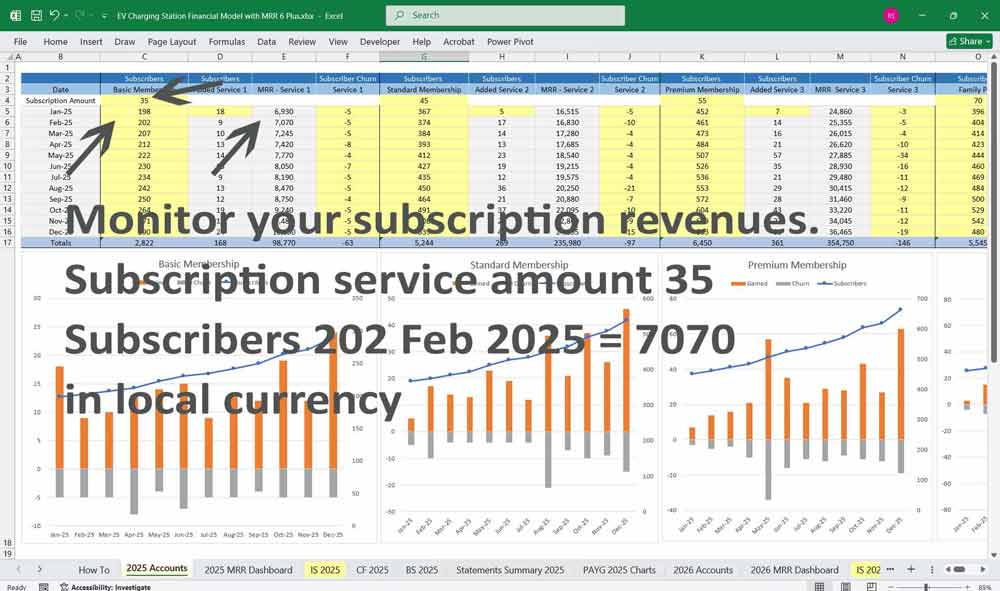
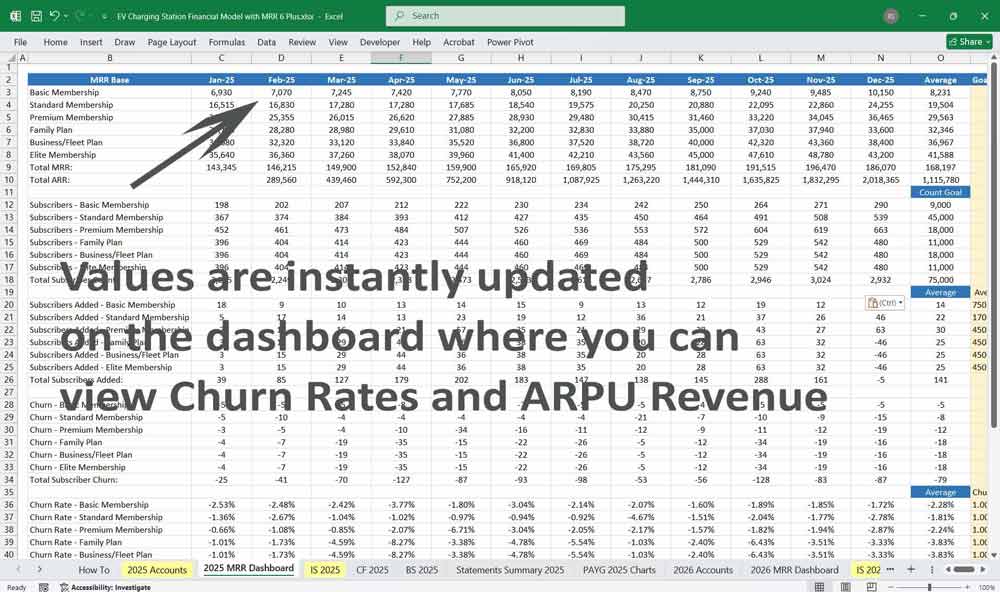
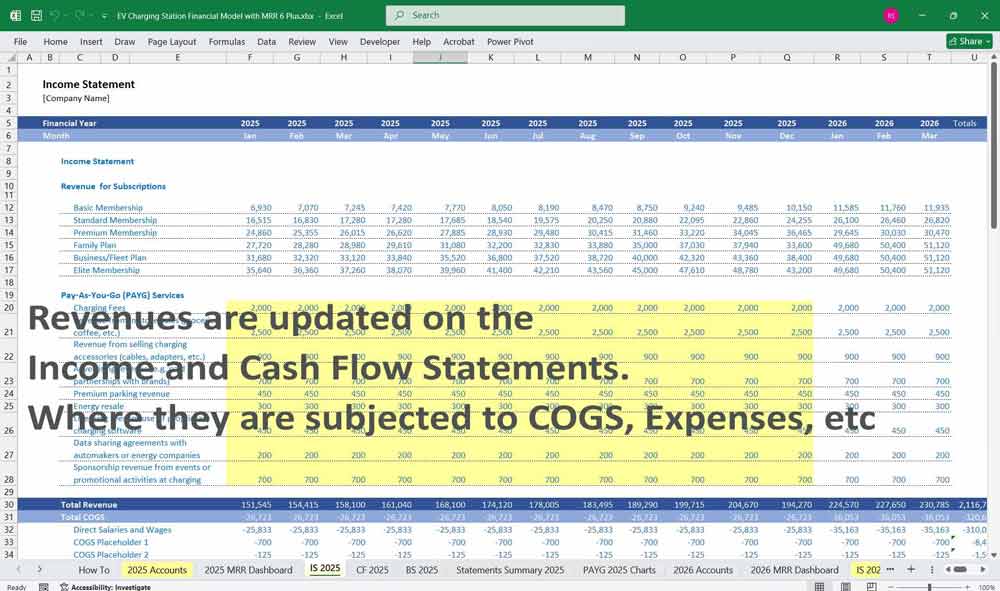
EV Charging Station Financial Model Cash Flow Statement
Tracks cash inflows and outflows, helping manage liquidity.
Operating Cash Flow
- Cash Inflows: Membership fees, pay-per-use revenue, event deposits.
- Cash Outflows: Salaries, rent, utilities, maintenance.
Investing Cash Flow
- Capital expenditures (CapEx) for new charging stations.
- Expansion costs (adding new software, remodelling).
Financing Cash Flow
- Debt financing for ev charging station expansion.
- Loan repayments, interest expenses.
Net Cash Flow
- Total Cash Inflows – Total Cash Outflows
- Should be positive to maintain a healthy business.
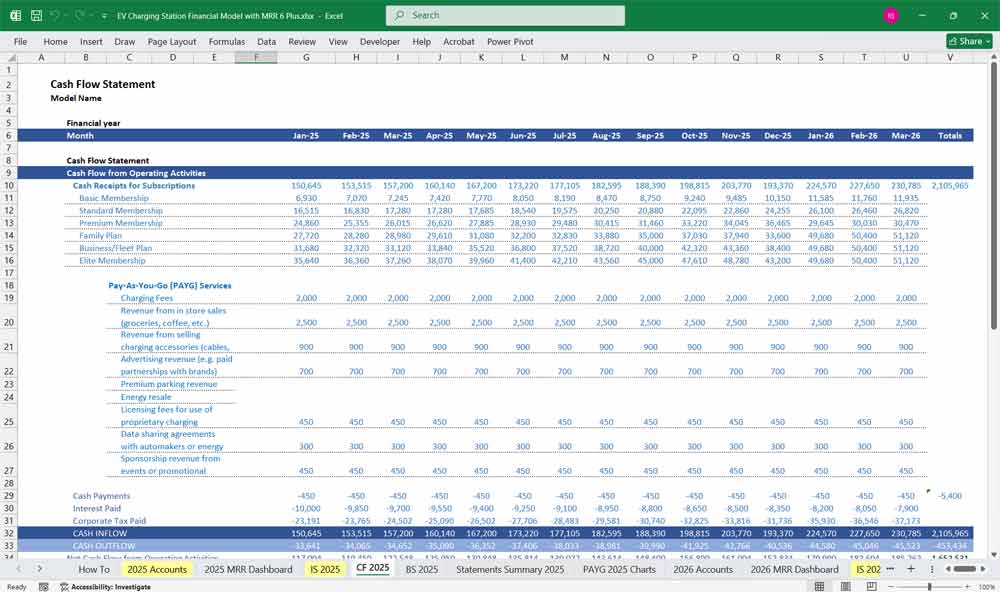
EV Charging Station Financial Model Balance Sheet
The Balance Sheet presents the EV charging station’s financial position, showing assets, liabilities, and equity.
Assets
- Cash & Cash Equivalents: Operating liquidity.
- Accounts Receivable: Outstanding customer payments.
- Inventory: Accessories, in-store items.
- Fixed Assets: Charging stations, real estate.
- Intangible Assets: Software, licenses.
Liabilities
- Accounts Payable: Outstanding expenses.
- Debt & Loans: Used for infrastructure investment.
- Deferred Revenue: Subscription fees are collected upfront.
Equity
- Initial Investment
- Retained Earnings (profits reinvested into the business)
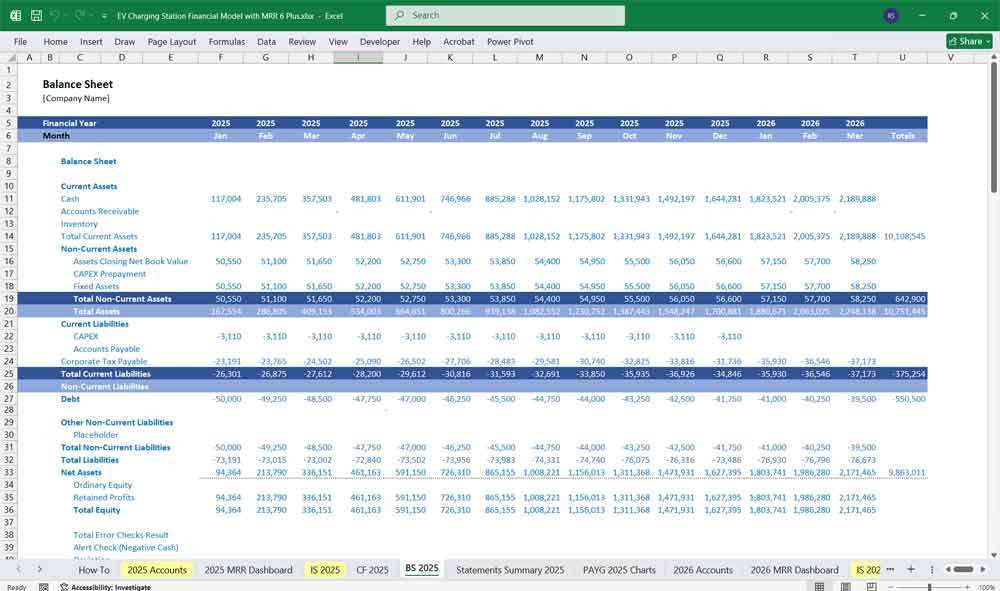
Business Overview & Key Assumptions
Business Overview
An EV Charging Station generates revenue through various streams, including pay-per-use charging, subscription plans, in-store sales, and premium services. This model accounts for:
- Initial Launch: Charging station with fast-charging and standard charging ports.
- Recurring Revenue Model: Membership fees and software licensing.
6-Tier Subscription Model for an
EV Charging Station
The subscription’s 6 tiers provide recurring revenue while offering additional benefits:
Tier 1: Free Tier (Basic EV Charging Station Access)
Target Audience: Casual EV users, first-time users, or those testing the service.
Features:
Access to basic charging stations (Level 1 or Level 2).
Pay-as-you-go pricing with no subscription fee.
Limited charging speed (e.g., reduced kW output).
No reservation options; first-come, first-served.
Basic customer support via email or chat.
Access to a mobile app for locating stations and monitoring charging sessions.
Pricing: Free to join, with higher per-kWh rates compared to subscription tiers.
Perks: None.
Goal: Attract new users and encourage them to upgrade to higher tiers.
Tier 2: Essential EV Charging Station Tier (Monthly Subscription)
Target Audience: Regular EV users who charge occasionally.
Features:
Access to Level 2 charging stations at a discounted rate.
Fixed monthly fee with reduced per-kWh pricing.
Ability to reserve charging slots (up to 2 hours in advance).
Faster charging speeds compared to the Free Tier.
Basic loyalty rewards (e.g., earn points for every charge).
24/7 customer support via phone.
Pricing: 10–10–20/month, with a 10–15% discount on charging rates.
Perks: Free charging session every 5 charges.
Goal: Build loyalty among moderate users.
Tier 3: Premium EV Charging Station Tier (Unlimited Charging)
Target Audience: Frequent EV users, commuters, and ride-share drivers.
Features:
Unlimited access to Level 2 and Level 3 (DC Fast Charging) stations.
Priority access during peak hours.
Advanced reservation options (up to 24 hours in advance).
Exclusive access to premium charging locations (e.g., near highways or city centers).
Enhanced loyalty rewards (e.g., double points for every charge).
Premium customer support with dedicated account managers.
Pricing: 50–50–80/month, with unlimited charging within the network.
Perks: Free charging session every month, complimentary car wash or maintenance discounts at partner locations.
Goal: Cater to high-frequency users and maximize recurring revenue.
Tier 4: Business EV Charging Station Tier (Fleet Solutions)
Target Audience: Fleet operators, delivery services, and corporate clients.
Features:
Customized charging plans for fleets (e.g., bulk pricing, dedicated stations).
Access to Level 2 and Level 3 charging stations across the network.
Real-time fleet monitoring and analytics via a dedicated dashboard.
Priority support with 24/7 emergency assistance.
Ability to reserve multiple charging slots simultaneously.
Custom branding options for charging stations (e.g., company logo).
Pricing: Custom pricing based on fleet size and usage.
Perks: Free installation of dedicated charging stations at business locations.
Goal: Secure long-term contracts with businesses and fleet operators.
Tier 5: VIP EV Charging Sttion Tier (Exclusive Access)
Target Audience: High-net-worth individuals, luxury EV owners, and executives.
Features:
Unlimited access to all charging stations, including ultra-fast chargers (e.g., 350 kW).
Guaranteed availability with no waiting times.
Personalized concierge service for charging needs (e.g., valet charging).
Exclusive access to private charging lounges with amenities (e.g., Wi-Fi, refreshments).
Complimentary maintenance checks for EVs during charging.
Tier 6: Ultimate EV Charging Station Tier (Exclusive Access)
Key Features and Benefits
a. Priority Access to Charging Stations
Guaranteed Availability: VIP Ultimate members receive priority access to all charging stations within the network, even during peak hours.
Reservation Privileges: Members can reserve charging slots up to 24 hours in advance, ensuring a spot is always available when needed.
Reduced Wait Times: Advanced algorithms prioritize VIP members in the queue, minimizing wait times.
b. Ultra-Fast Charging Speeds
Exclusive Access to High-Power Chargers: VIP members can use ultra-fast chargers (e.g., 350 kW) reserved exclusively for this tier.
Optimized Charging Sessions: Charging speeds are maximized, reducing the time spent at the station.
c. Discounted Charging Rates
Up to 50% Discount: VIP Ultimate members enjoy significantly reduced rates per kWh compared to standard users.
Flat-Rate Pricing Option: Members can opt for a flat monthly fee for unlimited charging within a specified limit.
d. Exclusive Amenities and Services
Lounge Access: Premium lounges at select charging stations offer complimentary beverages, snacks, Wi-Fi, and comfortable seating.
Valet Charging: Drop off your vehicle, and our staff will handle the charging process while you relax or attend to other tasks.
Car Wash and Detailing: Discounted or complimentary car wash services available at partnered locations.
e. Enhanced Support and Convenience
24/7 Dedicated Concierge: A personal concierge service is available to assist with reservations, troubleshooting, and route planning.
Real-Time Notifications: Receive updates on charging status, station availability, and maintenance alerts via the app.
Seamless Integration: Sync your subscription with in-car navigation systems for real-time charging station recommendations.
f. Sustainability Perks
Carbon Offset Credits: Each charging session includes carbon offset credits to support renewable energy projects.
Green Energy Charging: Priority access to charging stations powered by 100% renewable energy.
Expansion and Future Benefits
Network Growth: As the charging network expands, VIP members will have early access to new stations and technologies.
Exclusive Events: Invitations to EV-related events, product launches, and test drives.
Loyalty Rewards: Earn points for every charging session, redeemable for discounts, free charging, or merchandise.
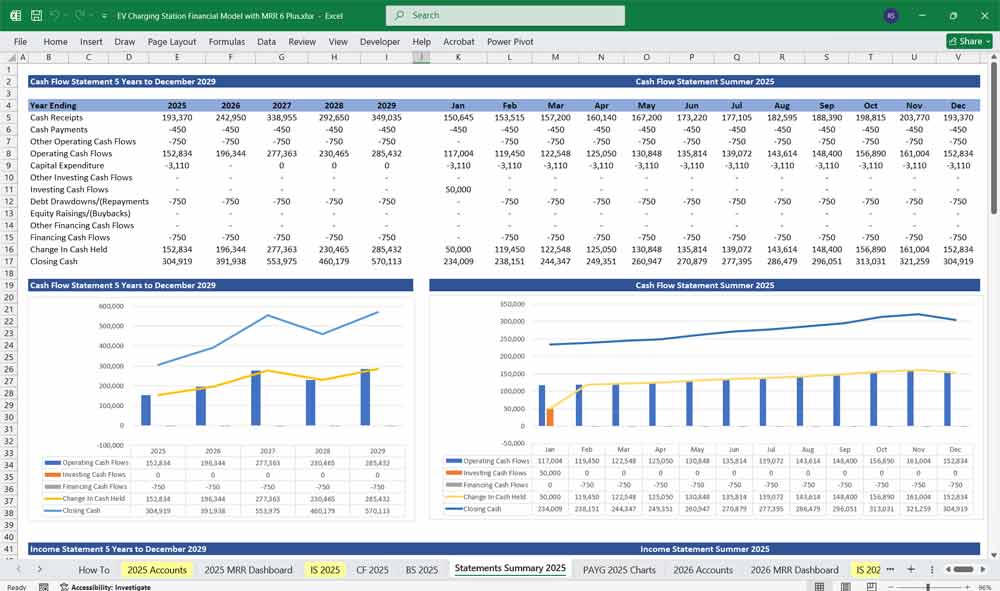
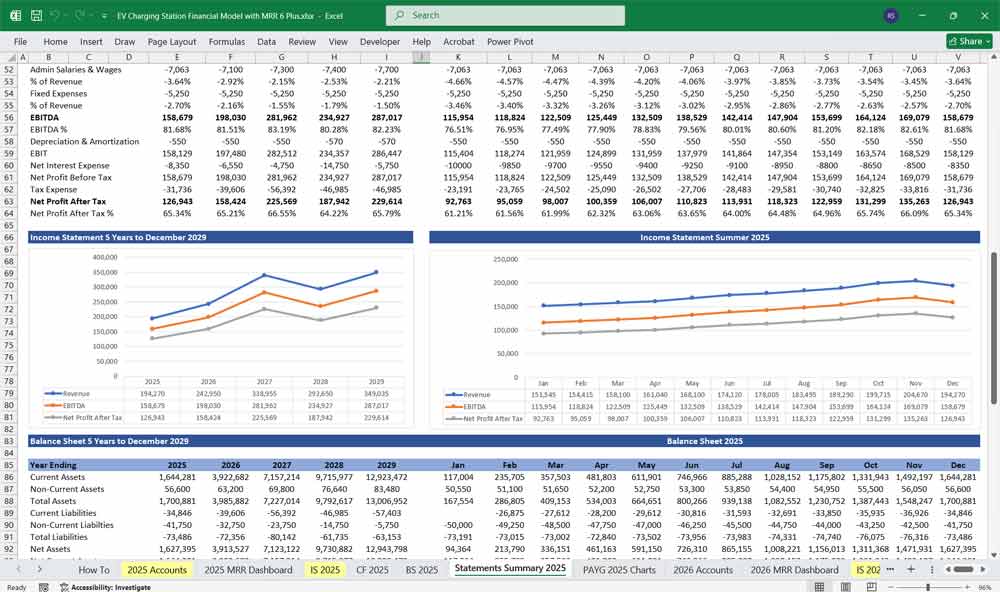
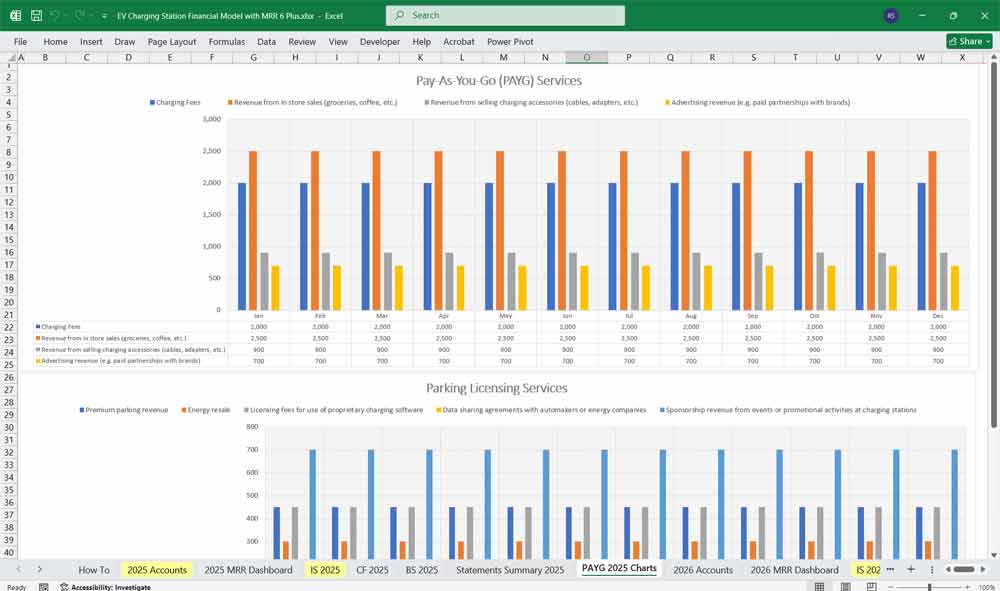
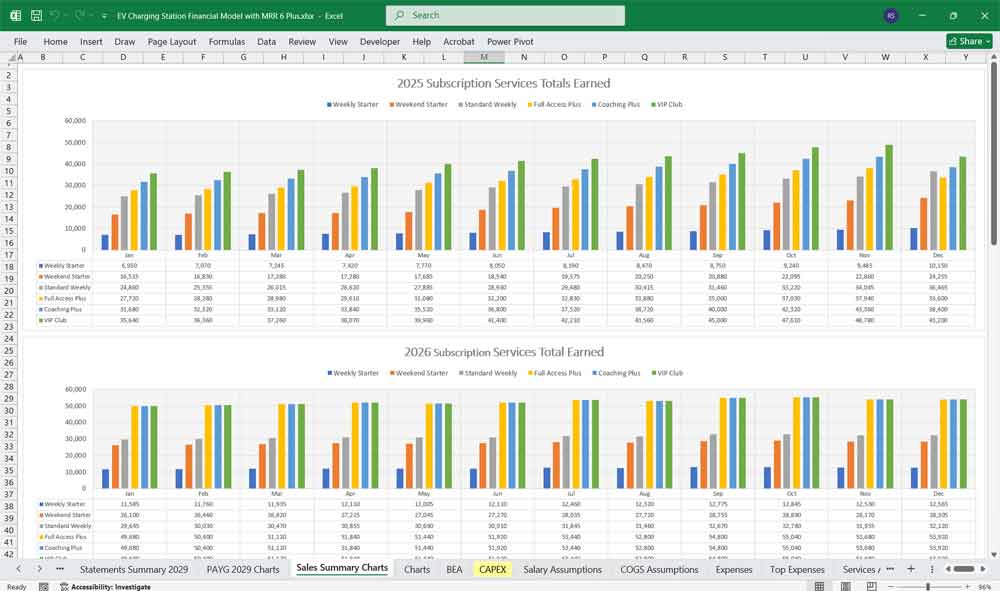
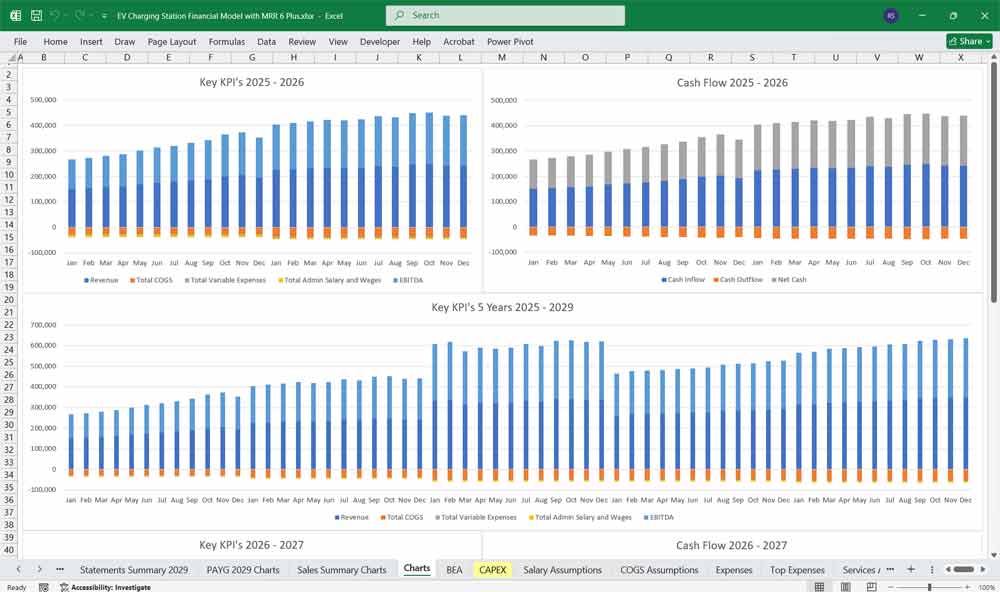
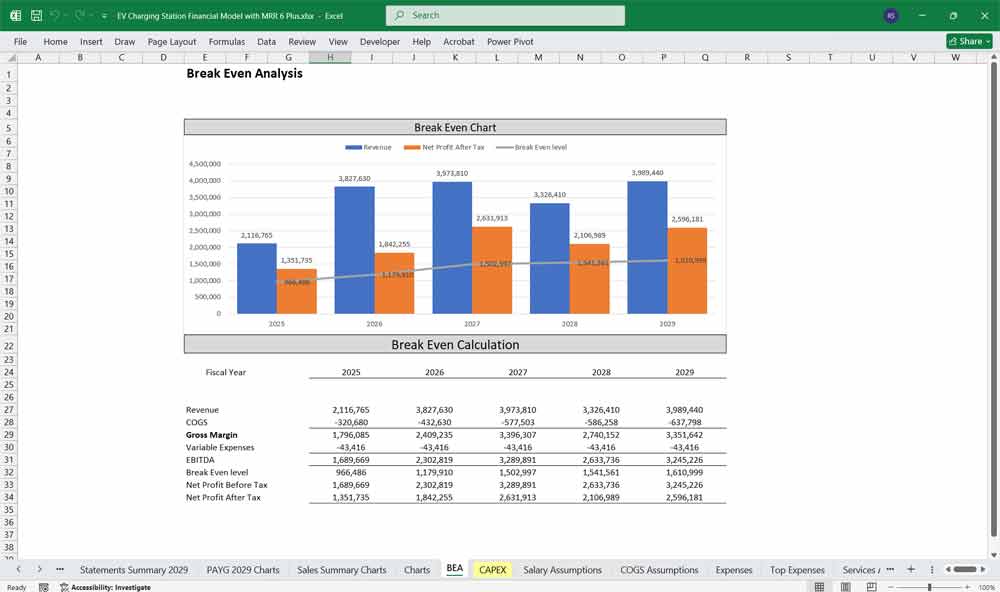
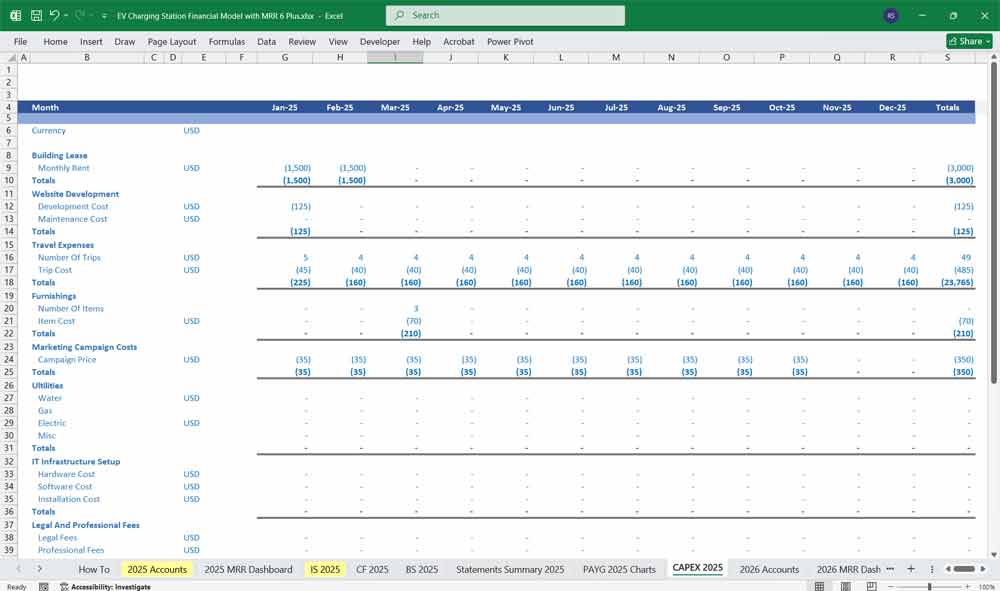
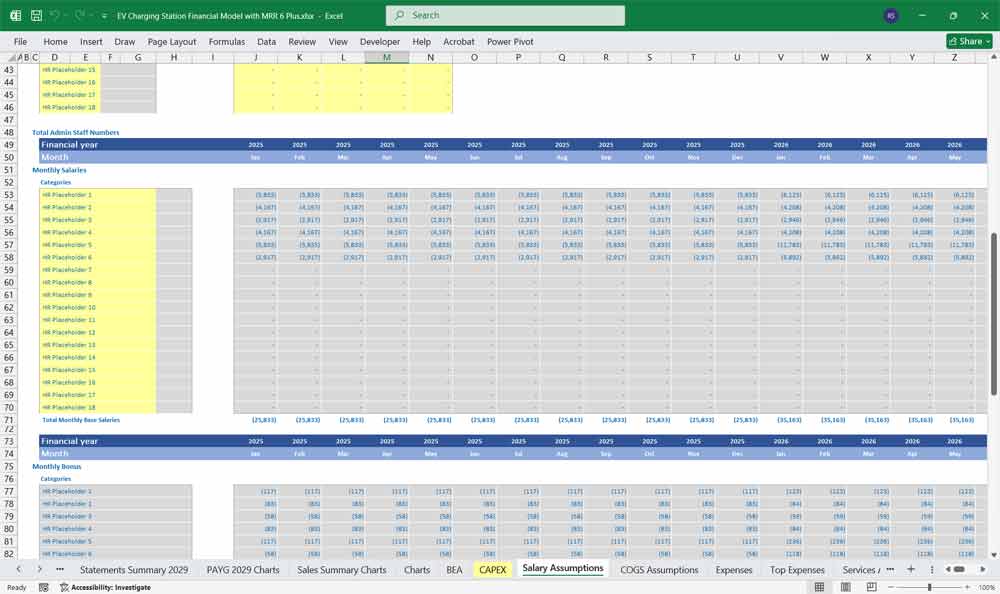

Final Notes On The Financial Model
This Electric Vehicle Charging Station Finance Model has:
- Profitability Focus: The station should aim for high-margin revenue streams (retainers and subscriptions).
- Cash Flow Management: Keep an eye on accounts receivable to avoid cash shortages.
- Scalability Strategy: Automate low-tier services to keep operational costs low.
- Long-Term Sustainability: Invest in branding, client loyalty, and technology to enhance efficiency.
Download Available Immediately After Payment
